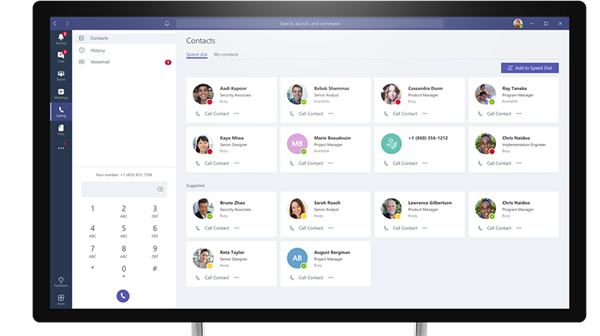- Articles
- The killer feature in Microsoft Teams your bu...
Table of Contents
An Amaxra consultant relayed an interesting customer insight recently when an Office 365 customer requested information on Microsoft Teams. “Maybe this is because I’m Generation X,” the customer confessed to our consultant. “But I really don’t ‘get’ Microsoft Teams. I just know all of the Millennials keep trying to use Slack on our network, so I need to get in front of that and add Teams to our Office 365.” This is an interesting insight for two reasons:
- It’s a real-world example of how organizations with multiple generations of workers respond to persistent chat and social networks in the enterprise. Independent research has shown that Millennials in the workplace show a preference for collaborating in team workspaces with instant messaging and humorous animated GIFs while the Gen Xers (and Baby Boomers) working in the same office want Outlook Email.
- Smart business leaders don’t want to bifurcate their IT and software spend along defined generational lines and—if they already have invested in Office 365—are turning to Microsoft Teams to provide a multi-generational collaboration solution.
The uptick we’ve seen in Microsoft Teams adoption among Amaxra customers is often based on that business-value calculation. Rather than thinking of Teams as a key component to a larger productivity-enhancing strategy for their business, some of our customers are reactionary; seeing the majority of the software development team surreptitiously installing Slack clients on their computers is enough to make most business owners nervous about the obvious potential for cybersecurity issues from unauthorized software on the corporate network. Moving to Microsoft Teams is a reaction to the issue of Slack infiltration rather than a “killer feature” in Teams that the business can’t do without.
However, Amaxra believes there is a real killer feature when it comes to Microsoft Teams: Its ability to replace your entire business phone system with a managed cloud service. This feature enables private branch exchange (PBX) business telephony capabilities from within Office 365. This feature enables employees to be so much more productive for such a relatively small effort that we’re surprised more businesses don’t use it.
Replace your business phone with the cloud
If you already have Office 365 and Teams, then you already know that anyone in your organization using Microsoft Teams can make voice over IP (VoIP) calls to any other team member using a Windows PC, Apple Mac/iPhone/iPad, and Google Android device running the Microsoft Teams app. However, these VoIP calls are essentially an intercom system for employees inside a company because the Teams app does not connect you to the public switched telephone network (PSTN). Most businesses connect to the PSTN using PBX hardware installed at an office location. Without access to the PSTN through a PBX, the Teams app cannot be assigned a phone number and therefore nobody outside your organization can dial a number and talk to you.
The telephony capabilities in Office 365 feature provides your business with a 100% cloud-based PBX system. Microsoft took the complicated and expensive equipment required at your office location to bridge your VoIP calls with the PSTN and made it a subscription service in the cloud. You can use Microsoft Teams exactly like you use your regular phone—and do it from any device running Teams and from anywhere in the world as long as you have internet access.
You can add Calling Plans that fit your business needs (e.g. your finance department employees only make domestic calls while sales makes both domestic and international calls) that provide standard telephone features, such as call answering and initiating (by name and number) with integrated dial pad, call holding and retrieving, call forwarding and simultaneous ringing, call history, voicemail, and emergency calling. Most importantly, you can do all of this from the Teams app on your laptop, tablet, and smartphone or from a wide array of Teams-compatible headsets and conference-room speakerphones from top brands if you have investments in “traditional” office phone hardware.

How to set up Telephony in Microsoft Teams
Microsoft Teams Telephony is available as an add-on to any Microsoft Office 365 plan. In Teams, there are two options to enable users to make, receive, and transfer calls to and from landlines and mobile phones on the PSTN:
- Enable Phone System and Calling Plans – In this option, Microsoft provides the phone number to your users and all PSTN services. Most small to midsized business (SMB) users go for this option because it’s a turnkey option that 100% in the cloud.
- Use Direct Connect – An option favored by larger organizations that use an existing PSTN connection via a Session Border Controller (SBC) hardware device that links to Microsoft Teams.
To get the most out of these options, we recommend you first envision how your employees will get the best experience out of Teams’ voice services. For example, never underestimate the importance of network quality. When a call from Teams goes to the cloud, to the PSTN, and finally reaches your intended recipient, one low-quality link in that network chain can cause problems. The majority of urban and suburban offices in North America, western Europe, and Oceania should have no problems sourcing sufficient broadband to make Teams Telephony work splendidly. However, we caution potential Teams users with offices in rural areas with aged wireline or spotty wireless internet that their experience will be less than optimal.
Get everyone ready to collaborate with Microsoft Teams
When you make the choice to deploy Teams Telephony at your company, there’s a good chance that you’ll see that generation gap open up again. It is very likely Millennials will start making calls using Microsoft Teams the day you offer it to them. Or they might not. And the Gen Xers could ‘get’ the Phone System but won’t get Teams. That’s why preparation for the change to Teams Telephony is crucial to success. Amaxra recommends that you educate employees on the benefits and process of using Teams Telephony a month prior to the rollout and for a month after the deployment.
Amaxra consultants have successfully deployed Microsoft Teams Telephony for numerous enterprise customers and are experts at training and supporting the service. We’re also such firm believers in the cloud-based voice collaboration solution that we dropped our onsite PBX hardware in favor of Phone System for our own employees.
